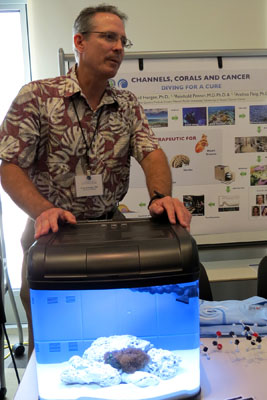
Hawai’i Pacific Chemistry Professor David Horgen, Ph.D., interim dean of the College of Computational and Natural Sciences, participates in a community science fair at the recent opening of the University of Hawai’i Cancer Center. Horgen’s research at HPU deals with finding possible anticancer drugs in coral.
By Staff Reports
(Honolulu) — A Hawai‘i Pacific University chemistry professor’s research team is examining compounds drawn from marine life that could have important cancer-fighting properties.
Working with respected researchers from the Queen’s Medical Center and the University of Hawai‘i Cancer Center, David Horgen, Ph.D., interim dean of HPU’s College of Computational and Natural Sciences, continues his innovative research in marine natural products chemistry that may lead to anticancer drugs. The HPU professor and two of his Queen’s Medical Center colleagues shared their findings at the recent grand opening of the UH Cancer Center, the state’s only research institution designated by the National Cancer Institute.
“We are fortunate to be collaborating on several projects with our colleagues at the center, one of the most prestigious research institutes in the Pacific,” Horgen said. “We have built an interdisciplinary team with expertise that spans natural products chemistry, ion channel biology, and animal cancer models.”
Horgen has teamed with UH and Queen’s Medical Center researchers to study the soft coral compound waixenicin A that may have cancer-specific therapeutic potential. Horgen, Andrea Fleig, Ph.D., and Reinhold Penner, M.D., Ph.D., both of the Queen’s Medical Center, staffed a booth during a science fair open to the public at the cancer center and displayed an aquarium tank with Sarcothelia edmondsoni, a soft coral endemic to Hawai‘i.
Many science fair visitors stopped to talk to Horgen and his colleagues, fascinated to learn that the coral in the aquarium could hold a cure for cancer.
“Waixenicin A is the first compound known that is capable of selectively shutting down the TRPM7 ion channel, a protein involved in cancer and stroke,” Horgen said.
TRPM7 is the main route for magnesium ions to enter the cells of mammals, he explained. “Because magnesium ions are so critical for the growth and division of cells, shutting down TRPM7 blocks cancer cell growth.”
Horgen added that blocking TRPM7 shortly after a stroke helps brain cells survive, potentially minimizing the negative effects of a stroke, another potential benefit of waixenicin A.
Collaborating with scientists with a wide variety of expertise is the key to cancer research, said Fleig. “It is an essential component to a fast-paced translation of discoveries at the research bench into clinical applications to help our patients.”
“The long-standing and successful collaboration between the laboratories of Drs. Horgen, Fleig and Penner is reflective of this modern approach in the biomedical sciences,” she added.
The work also continues at HPU to find other potential anticancer drugs, Horgen said, in faculty research supported by students in state-of-the-art laboratories.
“In other collaborations with the cancer center, HPU chemist Gideon Berger is synthesizing naturally occurring plant molecules that block a better defined target for intervening against cancer, that is disrupting the growth in the blood vessels that supply a tumor with nutrients,” Horgen said. “Through our unique contributions, we are able to be part of a larger fight against cancer, a disease that is a major killer in Hawai‘i and around the world.”
Learn more about Hawai‘i Pacific’s research in Chemistry (www.hpu.edu/chem) and Biochemistry (www.hpu.edu/biochem) online.
Hawai‘i Pacific University is the state’s largest private university with 7,500 students from the United States and more than 80 foreign nations. HPU is accredited by the Western Association of Schools and Colleges, the Council on Social Work Education, the National League for Nursing Accrediting Commission, and the Commission on Collegiate Nursing Education. See www.hpu.edu

